As the planet’s temperature becomes more unstable, fish are gradually learning to adapt to their changing environment. Now, many species of fish that have long been thought of as tropical can survive and thrive in cold water.
If you were asked to name a species of coldwater pet fish, you would most likely think of a goldfish or its relative, the Koi, a large freshwater fish with an elongated body and bright colors. But there are plenty of smaller fishes that don’t need a heater in their tank, even though they originate from warmer climes and temperate zones.
In this article, we take a look at the pros and cons of keeping coldwater fish, including a list of some surprisingly exotic fishes that can live in cool water, even in an outdoor aquarium or pond.
What Are Coldwater Fish?
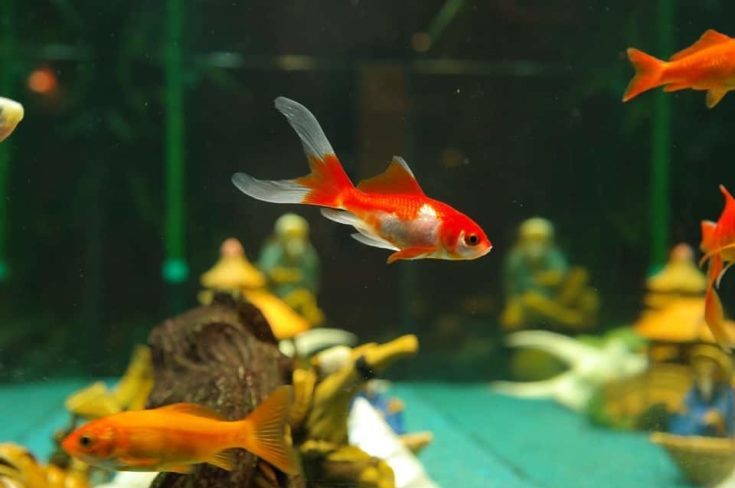
Coldwater fish are fish species that prefer to live in cooler water temperatures than most tropical fish. As far as aquarium fishes are concerned, coldwater species prefer water that is typically around or below 68° Fahrenheit.
The most commonly kept coldwater pet fish that you see in home aquariums are goldfish. Goldfish are members of the Cyprinidae family that includes the Prussian carp from which all varieties of goldfish are thought to be descended. Prussian carp are found in all the world’s temperate zones, although they originate from the chilly waters of Siberia. Other cyprinids include common carp, Koi carp, and minnows, all of which are coldwater fish.
Thanks to their origins, most types of goldfish and their relatives, Koi carp, can be kept successfully in outdoor ponds, surviving the cold of winter by hiding away in vegetation and the warmer depths of their habitat when the surface of the water freezes.
31 Best Fish Species For A Cold Freshwater Aquarium
Now that you know a little more about coldwater fish species that can thrive in a home fish tank let’s take a look at what different types of fish you could choose to keep. Many of these fish are more often seen in tropical tanks, but they can thrive in an aquarium without a heater, provided that the room temperature doesn’t fall too low and remains relatively consistent.
1. White Cloud Mountain Minnow
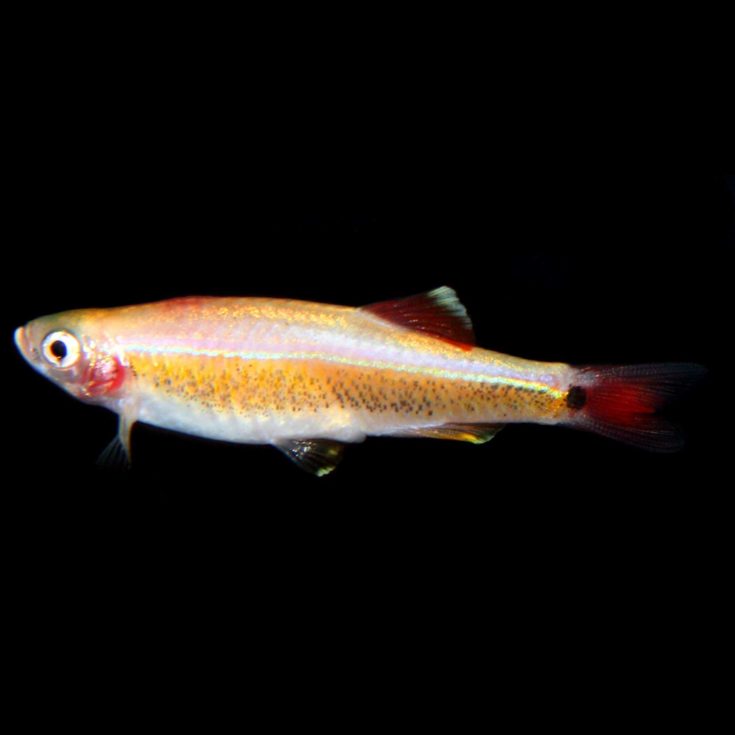
- Size: 1.5 inches
- Care difficulty: Easy/Beginner
- Minimum tank size: Nano tank
- Water temperature: From 60° to 70°
The White Cloud Mountain Minnow (Tanichthys albonubes) is extremely easy to care for and lives happily in a coldwater tank, although if the temperature falls too low, the fish’s attractive coloration does fade.
The wild populations of these pretty little fishes are almost extinct in their native China, largely due to pollution. However, these minnows are easy to breed in captivity, so the specimens you find in fish stores will not be wild-caught. In fact, you can often pick up Mountain minnows cheaply in pet stores where they are sold as feeder fish.
2. Mosquito Fish
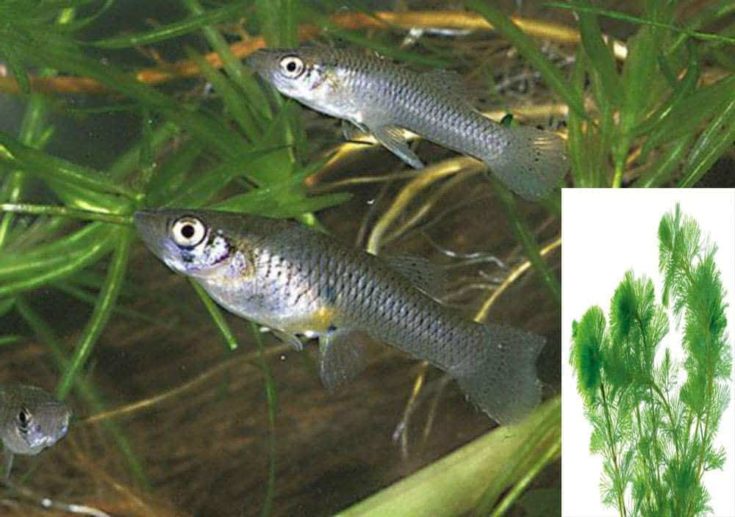
- Size: 1 inch
- Care difficulty: Easy/Beginner
- Minimum tank size: Nano tank
- Water temperature: From 40° to 80°
Mosquito fish are sometimes mistaken for female guppies, as they look quite similar. However, Mosquito fish are rather drab in color and are often overlooked by hobbyists in favor of their more colorful cousins.
These shiny gray fish make lively additions to the tank and can even be kept in an outdoor aquarium or pond, where they do a great job at eating mosquito larvae, hence their name.
3. Rosy Barb
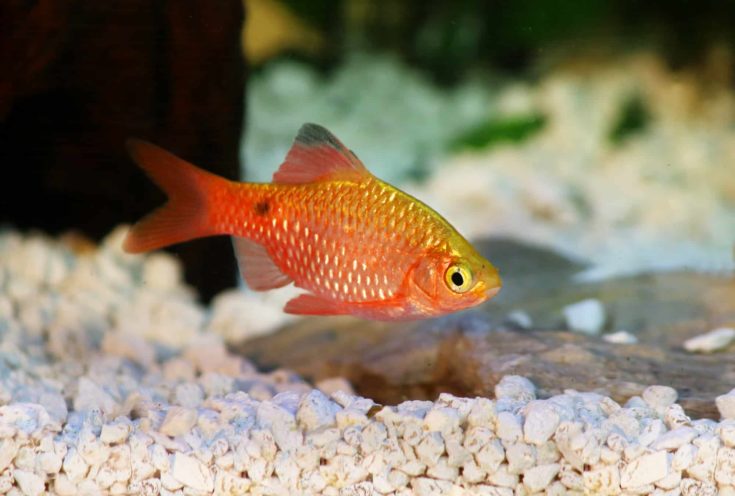
- Size: 6 inches
- Care difficulty: Easy/Beginner
- Minimum tank size: 30 gallons
- Water temperature: 60° to 70°
The Rosy barb (Barbius conchonius) originates from Bangladesh and Afghanistan and is the hardiest member of the barb family, happily surviving in a coldwater or cooler tropical tank. These attractive, lively little fish make a great display when kept in a small school and are very easy to care for. You can keep Rosy barbs safely in a community setup, as they are not aggressive like some of their more feisty relatives, such as the Tiger barb.
4. Gold Barb
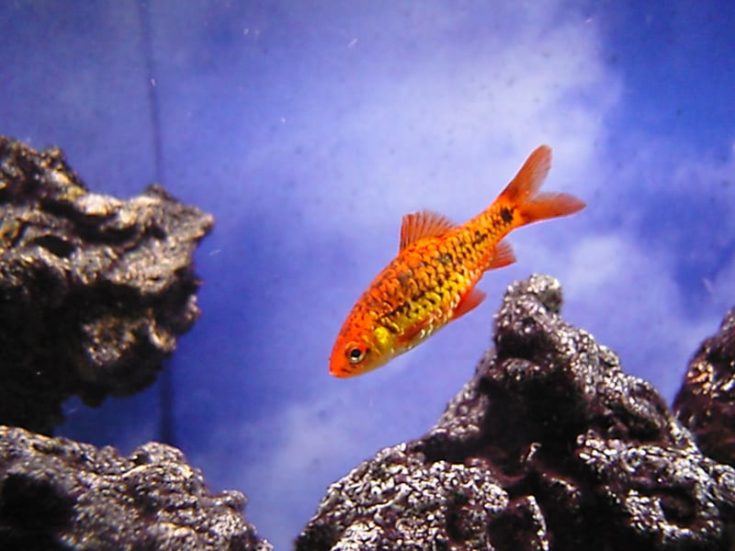
- Size: 2 to 3 inches
- Care difficulty: Easy/Beginner
- Minimum tank size: 30 gallons
- Water temperature: 60° to 70° degrees
The Gold barb (Barbus schuberti) is also known as the Chinese barb and is a coldwater aquarium fish that’s rapidly gaining in popularity.
These stunning little fish are a beautiful golden yellow color that makes a real statement in your tank when kept in a small school of six or seven individuals. Although Gold barbs can be kept in a community tank, they are a little more aggressive than Rosy barbs and do particularly well when kept with other barb species.
Gold barbs can also sometimes be found in a less common green shade.
5. Two-Spotted Barb
- Size: 2 to 3 inches
- Care difficulty: Easy/Beginner
- Minimum tank size: 30 gallons
- Water temperature: 60° to 70°
The Two-spotted barb (Puntius bimaculatus) is an unusual fish that is seldom found in pet stores, although it can be bought through online dealers. Wild populations of the fish are under threat, largely due to habitat destruction, although the more brightly colored specimens are often harvested for the trade. That has led to patchy populations, and, in some areas, the species is no longer found at all.
The fish originates from inland waters in Pakistan, India, and Nepal, and is generally a silvery color with two dark spots on its body. However, the color of the Two-spotted barb’s lateral line depends on the diet that is available to it, varying from red to yellowish-gold.
6. Bloodfin Tetra
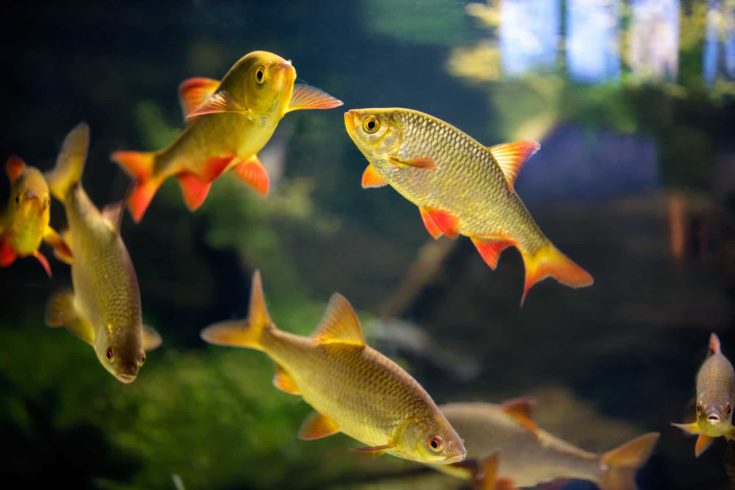
- Size: 2 to 3 inches
- Care difficulty: Easy/Beginner
- Minimum tank size: 30 gallons
- Water temperature: 60° to 70°
The Bloodfin tetra (Aphyocharax anisitsi) is a gorgeous little fish that makes a great choice for a beginner, as they are quite hardy and easy to look after. These fish are readily available in fish stores and pet shops, where you’ll often find them on display alongside their relative, the False Bloodfin tetra (Aphyocharax dentatus).
These fish are rather shy and timid, so you need to keep them in a school of at least six individuals, and be sure to provide plenty of dense planting where the tetras can shelter.
7. Rainbow Goodeid
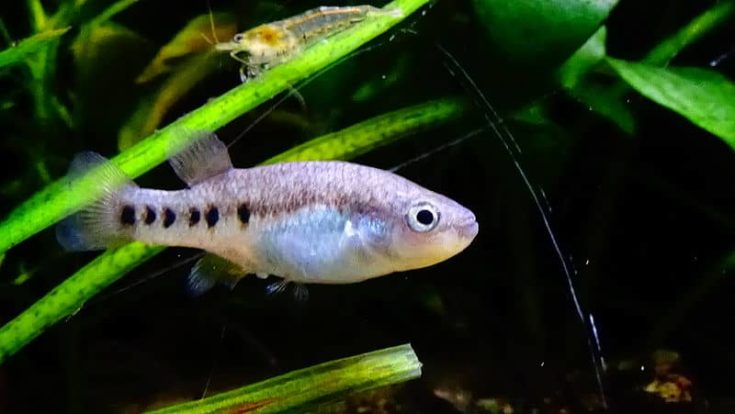
- Size: 2 inches
- Care difficulty: Easy/Beginner
- Minimum tank size: 30 gallons
- Water temperature: 65° to 73°
The Rainbow Goodeid (Characodon lateralis) makes a very unusual addition to the aquarium and is, sadly, not often seen for sale in fish stores. That’s a real shame because these are pretty little fish with cute, smiling faces that resemble the characterful pufferfish, although the two species are not related.
These fish are easy to look after and undemanding in terms of water and tank conditions, making them ideal for beginners.
Rainbow Goodeids come from Durango State in Central Mexico, but their numbers have declined considerably in recent times, leaving the fish listed as “Critically Endangered” on the IUCN Red List.
8. Buenos Aires Tetra
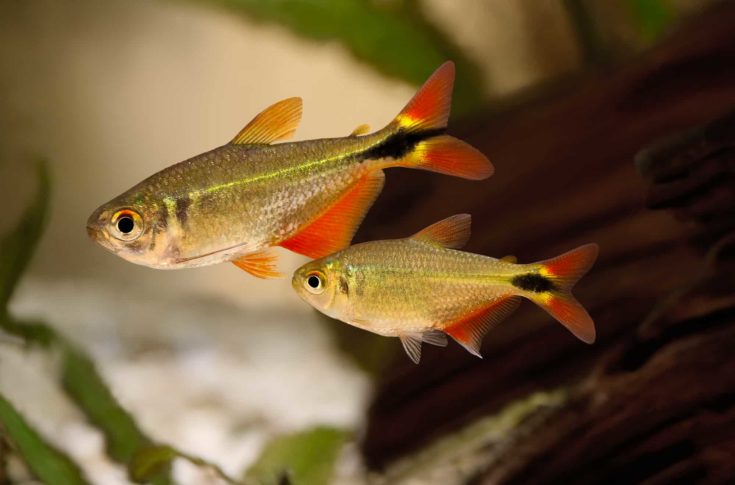
- Size: 2 to 3 inches
- Care difficulty: Easy/Beginner
- Minimum tank size: 30 gallons
- Water temperature: 64° to 82°
The Buenos Aires tetra (Hyphessobrycon anisitsi) is readily available for sale in fish stores and makes an active, attractive addition to the community, coldwater aquarium. The fish also come in an albino variant, which can make a beautiful addition to a shoal of eight or more individuals.
Although these lively tetras are hardy and easy to care for, they can be a nightmare if you keep live plants in your tank, as they will voraciously eat them. For that reason, Buenos Aires tetra’s popularity has waned somewhat in recent years. Most specimens that you see for sale are captive-bred by commercial fish breeding operations in Florida.
9. Hillstream Loach
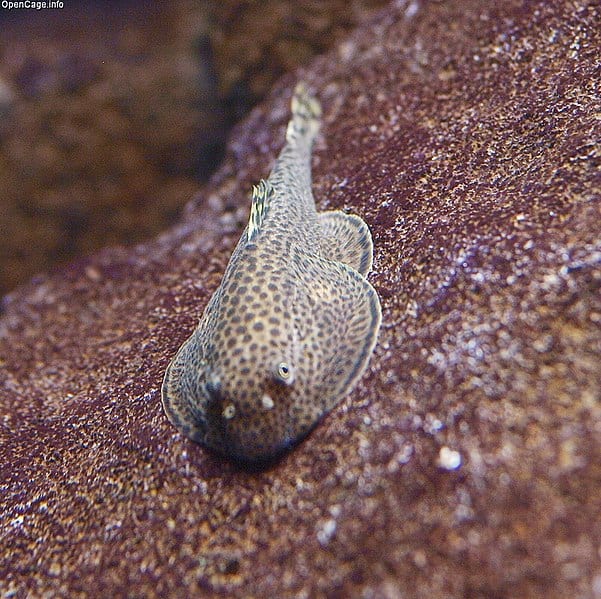
- Size: Up to 3 inches
- Care difficulty: Easy/Beginner
- Minimum tank size: 30 gallons
- Water temperature: 69° Fahrenheit and above
The Hillstream Loach comes from South and East Asia. Loaches make a very useful and quirky addition to the coldwater aquarium, as they live on the substrate and flat surfaces, eating both brown and green algae and helping to keep the environment clean and tidy.
These loaches do need slightly warmer water than in the upper sixties Fahrenheit range, so you will need a tank that’s kept in a relatively temperate room in your home for these fish to thrive.
If conditions are right, you may find that your loaches start spawning, and you finish up with a bunch of mini alien lookalikes inhabiting your tank!
10. Pearl Danio
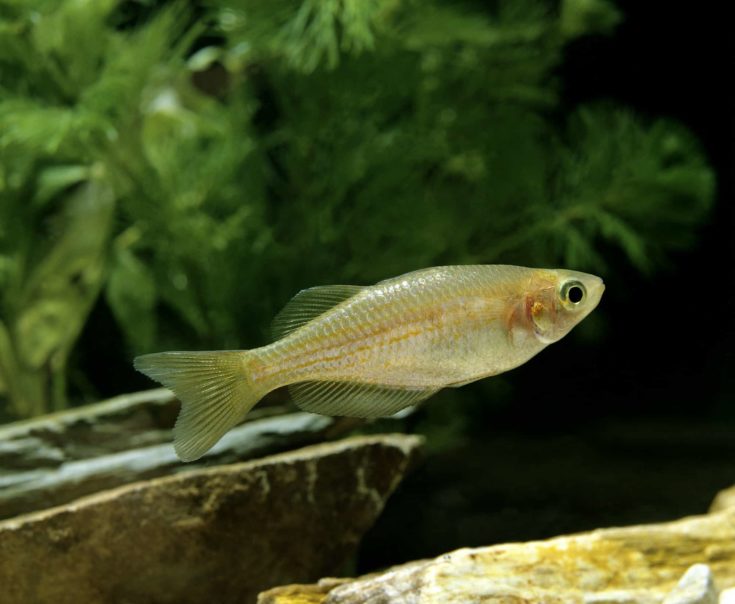
- Size: 2 inches
- Care difficulty: Easy/Beginner
- Minimum tank size: Nano tank
- Water temperature: Around 65° Fahrenheit
The Pearl danio (Danio albolineatus) from Thailand and Sumatra is a hardy, easy-care fish that’s ideal for a newbie to the hobby.
These fish are readily available in your local fish store, and they aren’t expensive to buy. Often, you can buy a small shoal of danios at a discount, and that’s great news for you and for these schooling fishes.
Pearl danios are lively, attractive little fishes that can be kept in a small tank or nano aquarium with cool water and a pH level of 6.8 to 8.0. When aquascaping your tank, make sure that you provide plenty of lush planting and hiding places for these shy fishes. These fish will spawn in captivity when given the right conditions, and the males’ courtship display is an entertaining spectacle that can really add interest to your display.
11. Odessa Barb
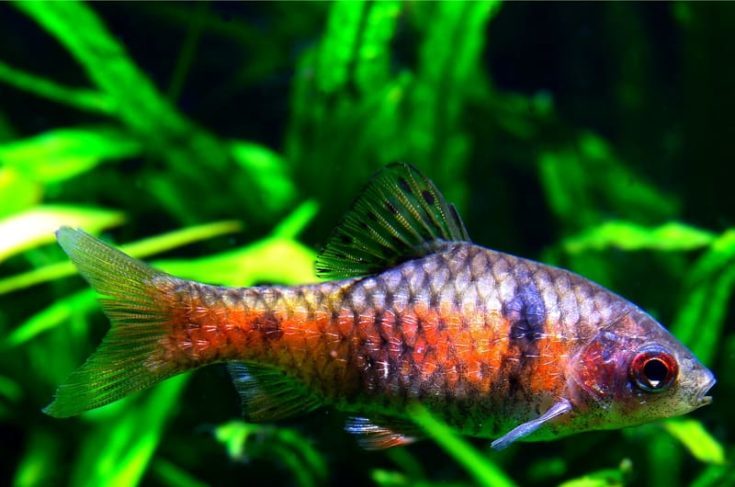
- Size: 3 inches
- Care difficulty: Easy/Beginner
- Minimum tank size: 30 gallons
- Water temperature: Between 65° and 75° Fahrenheit
Odessa barbs come from Indonesia, Sumatra, and Borneo. These fish are absolutely stunning to look at, especially when displayed in a large school, ideally of more than six individuals. The fish’s body coloration is predominantly black with a bright red lateral stripe and black spotted fins.
Although you can keep Odessa barbs in a community tank, they do have a habit of nipping other fish. However, like Tiger barbs, if you increase the number of fish in the school, the issue usually resolves itself.
12. Sunset Variatus Platy
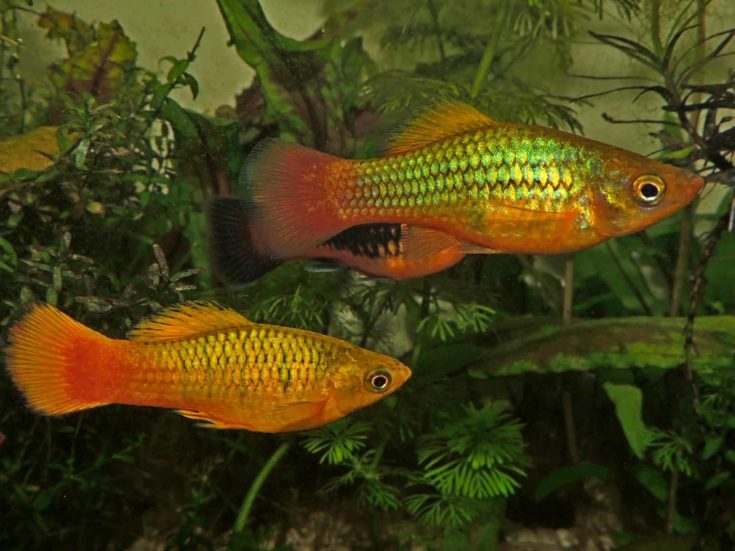
- Size: 2 to 3 inches
- Care difficulty: Easy/Beginner
- Minimum tank size: 30 gallons
- Water temperature: Between 61° and 75° Fahrenheit
The Sunset Variatus Platy (Xiphophorus variatus) is a beautiful little fish that bears live young, usually frequently and in large numbers!
These fish are perfect for a beginner’s tank, as they are extremely hardy and inexpensive to buy. Platys come in a huge range of patterns and colors, and they will live peacefully in a large group. So, if you want to keep things simple, you might want to consider keeping a species-only Platy tank.
Although Platys aren’t fussy when it comes to water temperatures, they do prefer pH levels above 7.0. Provide your fish with lots of live plants, driftwood, and caves to explore, and they will reward you with hours of enjoyment (and lots of babies!)
13. Weather Loach
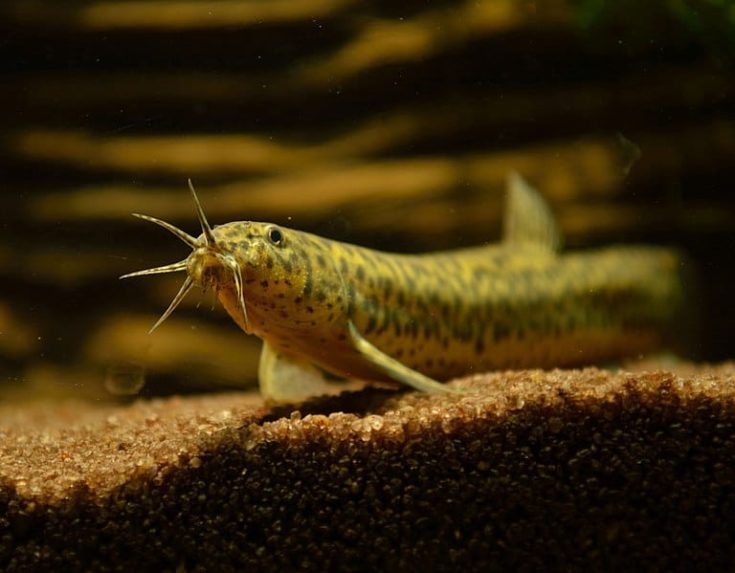
- Size: 5 to 8 inches
- Care difficulty: Easy/Beginner
- Minimum tank size: 30 gallons
- Water temperature: In the 50° Fahrenheit range
Weather loaches are also known as Pond loaches (Misgurnus anguillicaudatus) come from East Asia. These fish are extremely easy to care for and will tolerate low water temperatures, too, making them the ideal addition to a cold water tank, especially if you want something a little quirky in your collection.
Interestingly, Weather loaches become more active when the atmospheric pressure drops right before a storm, which is how they came by their common name. These bottom-dwellers have an elongated body shape like that of an eel, and three sets of barbels around their mouths give them a weird mop-like appearance. These fish can be gray, albino, or pink, further adding to their appeal.
14. Zebra Danio
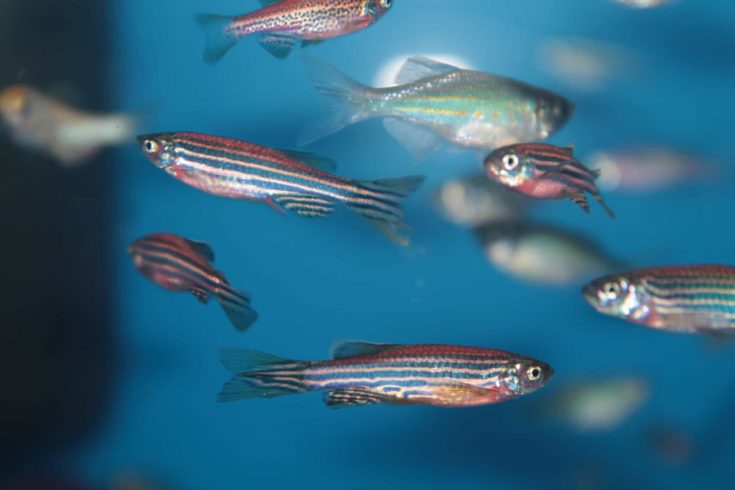
- Size: 0.5 to 1.5 inches
- Care difficulty: Easy/Beginner
- Minimum tank size: 10 gallons
- Water temperature: In the mid-60° Fahrenheit range
The tiny Zebra danio (Brachydanio rerio) comes from South Asia and is readily available from pretty much all fish stores. These active little fishes make a great addition to a coldwater nano tank and they’re also super-easy to care for.
There are many varieties of danio, including some with long fins and the very popular leopard-spotted danio.
15. Rainbow Shiner
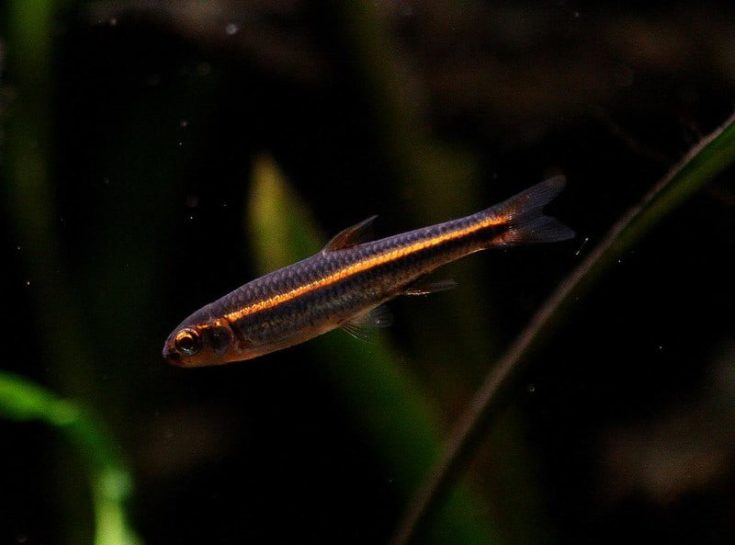
- Size: 3 to 3.5 inches
- Care difficulty: Easy/Beginner
- Minimum tank size: 30 gallons
- Water temperature: In the mid-60° Fahrenheit range
The brilliantly colored Rainbow Shiner (Notropis chrosomus) is a cool water fish that is native to the United States. These stunning, torpedo-shaped fishes are vibrant purple and pink, and they are especially sparkling during the spawning season.
These beautiful fish are peaceful creatures that can be kept in small schools of at least six individuals and make a glittering addition to a community tank. The main downside to the Rainbow Shiner is that they are not always easy to find and, consequently, they do command a high price.
16. Empire Gudgeon
- Size: 4.7 inches
- Care difficulty: Intermediate
- Minimum tank size: 30 gallons
- Water temperature: 72° to 82° Fahrenheit
The Empire Gudgeon (Eleotris compressus) is a native of Australia and Papua New Guinea and is a truly striking fish with a red and tan-colored body and brilliant red finnage edged with white and black bands.
Although these fish can be kept in a cool aquarium, the water temperature should not drop below around 72° for long periods. Empire Gudgeons are not commonly seen for sale in fish stores, but you can sometimes find specimens online.
Most fish in the trade are wild-caught, and they usually need a diet of live or frozen food to thrive. So, you’ll need to be ready to provide your fish with brine shrimp, bloodworms, mosquito larvae, and daphnia.
17. Endler’s Livebearer
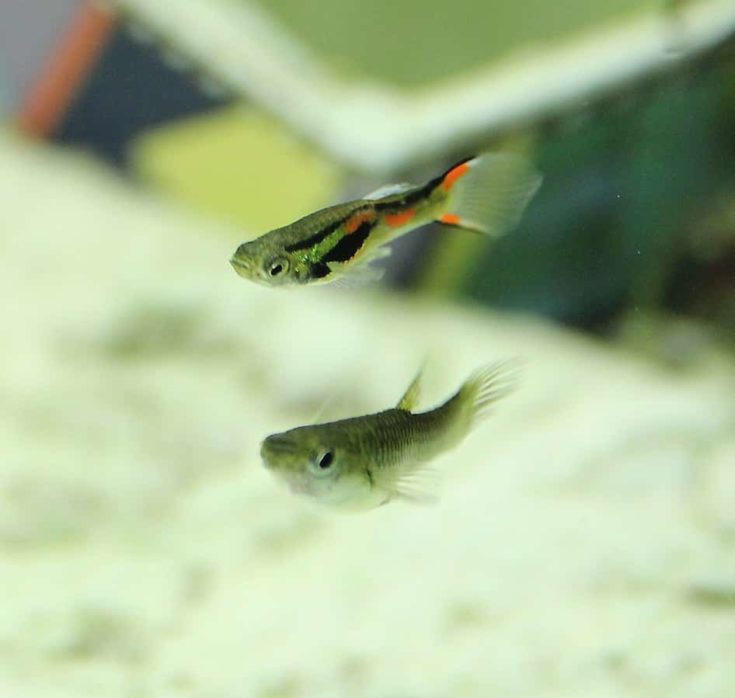
- Size: 1 to 1.8 inches
- Care difficulty: Intermediate
- Minimum tank size: Nano tank
- Water temperature: 75° to 86° Fahrenheit
The brightly colored Endler’s livebearer comes from several isolated locations in Northeastern Venezuela. At one time, it was thought that the fish had been overfished to extinction until a small population was discovered in one small area. However, Endler’s breed at such a rapid rate that their numbers soon recovered, and the species is not considered endangered today.
A school of these tiny fishes makes a beautiful display as they flit in and out of the plants in a peaceful community tank. Although Endler’s lifespan is relatively short at just a few years, their continual spawning habit means that you’ll never be short of these swimming gems.
18. Bristlenose Pleco
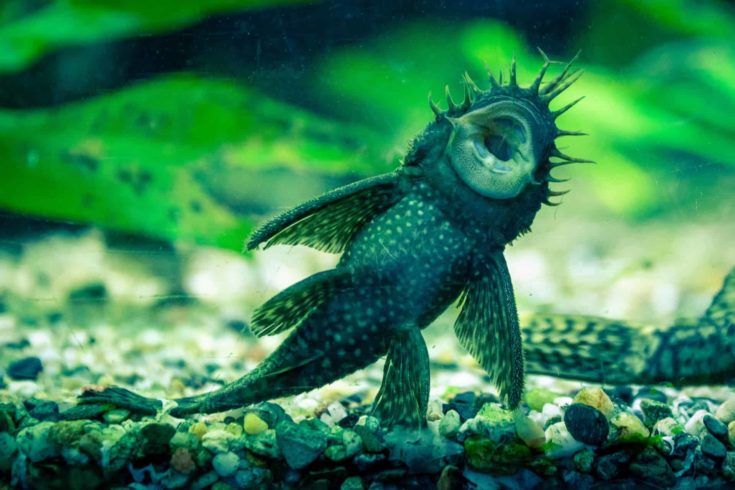
- Size: 3 to 5 inches
- Care difficulty: Easy/Beginner
- Minimum tank size: 20 gallons
- Water temperature: 73° to 81° Fahrenheit
The Bristlenose pleco (Ancistrus Cirrhosus) is a small species of plecostomus catfish that makes an interesting and useful addition to a coldwater tank setup. These quirky fish spend most of their time on the substrate or eating algae, which they scrape from tank surfaces with specially adapted teeth.
This species of pleco is a peaceful creature that lends itself well to life in a community tank. However, once they reach maturity, plecos are quite territorial and don’t get along with their own kind. So, if you take on a Bristlenose, you must only have one.
19. Clown Killifish
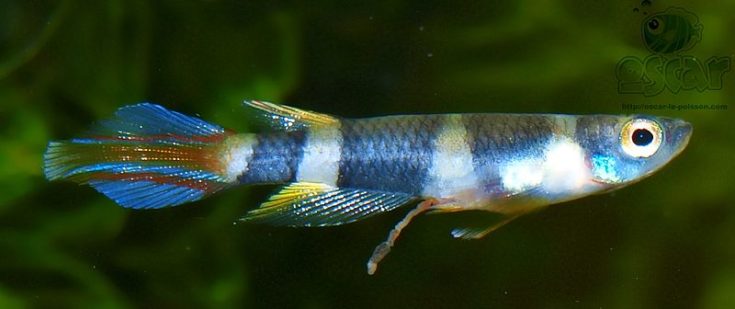
- Size: 1 inch
- Care difficulty: Easy/Beginner
- Minimum tank size: Nano tank
- Water temperature: 68° to 79° Fahrenheit
The Clown killifish (Epiplatys annulatus) is a perfect candidate for a coldwater nano tank setup and gets along well with other small fish species. These pretty little fish spend much of their time in the upper part of the water column, and they are well-known jumpers, so do make sure that your tank has a cover slide or a tight-fitting lid.
If provided with a well-planted tank and a nutritious diet, these delightful little fishes will readily breed, so you will never need to buy any more!
20. Dojo Loach
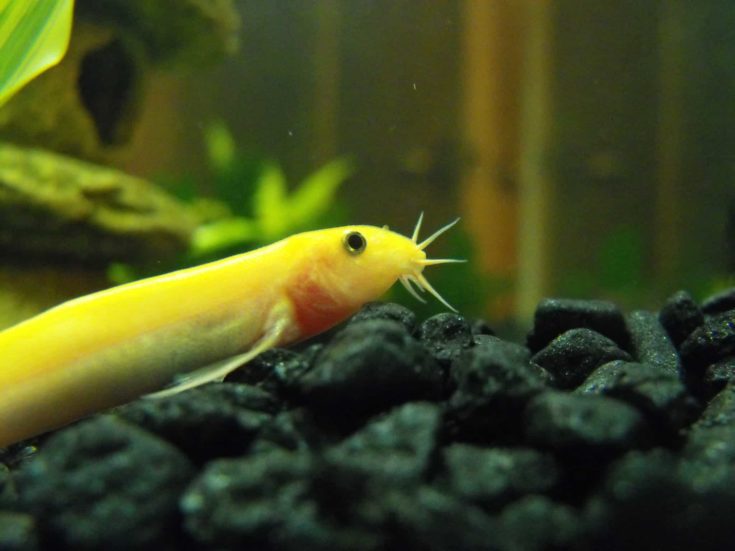
- Size: 6 to 10 inches
- Care difficulty: Easy/Beginner
- Minimum tank size: 40 gallons
- Water temperature: 60° to 79° Fahrenheit
The Dojo Loach is a long, fat loach with a cylindrical body and tiny stubby fins. These fish live on the bottom of the tank, ideally in schools of at least six individuals and in a tank that has a soft, sandy substrate. That’s because these fish are habitual burrowers and could sustain an injury if the substrate is too coarse.
Dojo loaches come in silver with black spots or a bright yellowish-gold color that is truly eye-catching.
21. Rosy Red Minnow
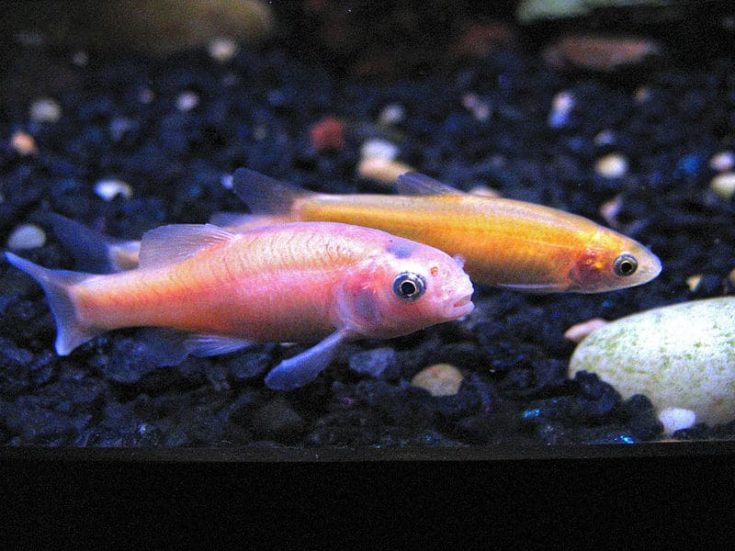
- Size: 2 to 4 inches
- Care difficulty: Easy/Beginner
- Minimum tank size: 30 gallons
- Water temperature: 50° to 70° Fahrenheit
Rosy Red minnows are often sold in fish stores as feeder fish. That’s great news for you if you’re looking for some hardy, pretty fish with which to stock an outdoor aquarium or pond, as Rosy Red minnows are typically sold in bulk at cheap prices.
These attractive, lively fishes can survive extremes of temperature from as low as 40° right up to 100° Fahrenheit.
22. Fancy Goldfish
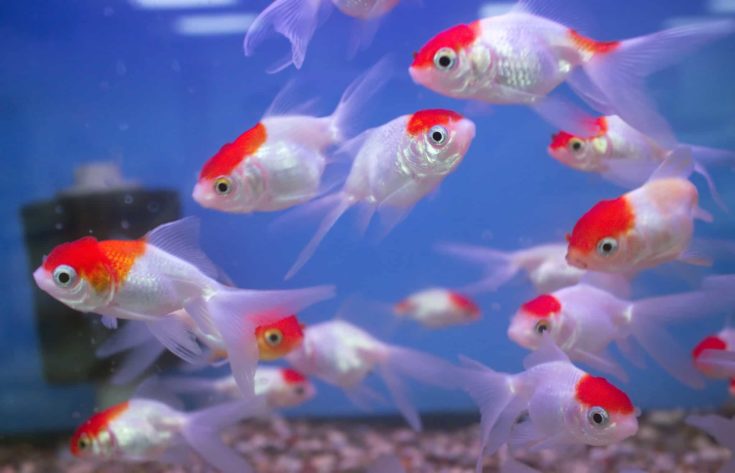
- Size: 2 to 4 inches
- Care difficulty: Easy/Beginner
- Minimum tank size: 50 gallons
- Water temperature: 60° to 80° Fahrenheit
Fancy goldfish are one of the coolest choices for a cold water tank, as they don’t grow as large as other species of common goldfish and comets, which are a better choice for ponds.
The humble goldfish come in many beautiful colors, shapes, and sizes and are relatively easy to care for. However, these are social creatures that should be kept in pairs or small groups. Also, goldfish are very dirty fish, so you will need to have an efficient filter system in your tank, and you will also need to carry out weekly maintenance to keep the environment healthy.
23. Paradise Fish
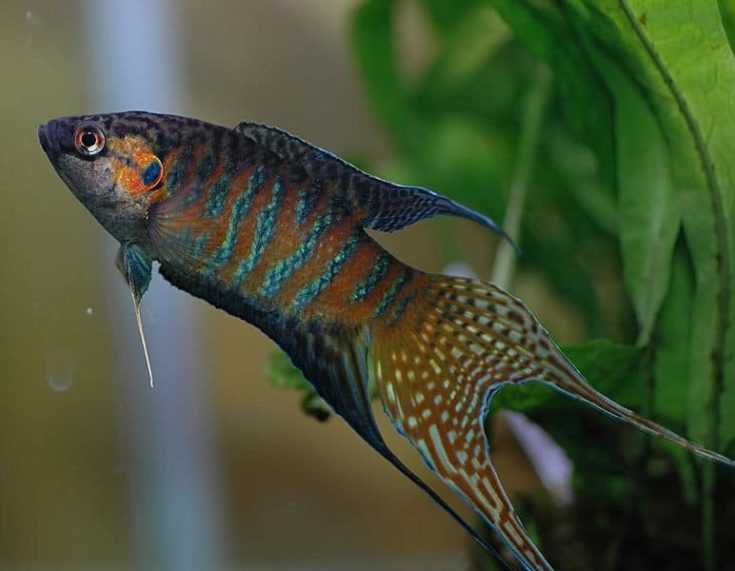
- Size: 4 inches
- Care difficulty: Intermediate
- Minimum tank size: 30 gallons
- Water temperature: 60° to 85° Fahrenheit
Paradise fish are a species of gourami with glorious floating fins and the most beautiful coloration.
Unfortunately, Paradise fish can be aggressive and nippy, so you’ll need a big tank to house these glamorous creatures. That being said, you can still have a community setup, provided that you choose placid fish that won’t come into conflict with the feisty Paradise fish.
Also, don’t clutter the tank with too many thick plants and ornaments, as these fish like plenty of swimming space.
24. Asian Stone Catfish
- Size: 1.5 inches
- Care difficulty: Intermediate
- Minimum tank size: 10 gallons
- Water temperature: 60° to 75° Fahrenheit
The Asian Stone catfish is an interesting looking fish that can adapt to life in a coldwater aquarium provided that the water temperature remains between 60° to 75° Fahrenheit.
Although these are small fish and would do okay in a nano tank, they do best when kept in a small shoal of around six or more, so a larger tank is better. Asian Stone catfish make a nice addition to a community tank, being peaceful fish that get along well with others.
25. Medaka Ricefish
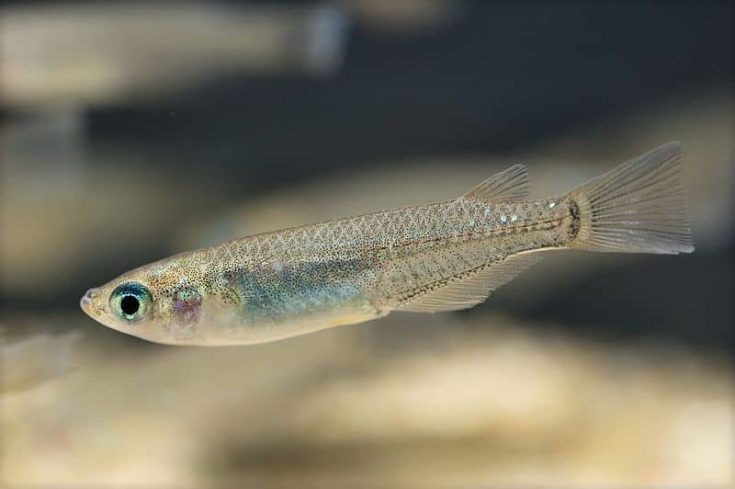
- Size: 1.5 inches
- Care difficulty: Easy/Beginner
- Minimum tank size: 10 gallons
- Water temperature: 40° to 80° Fahrenheit
Medaka Ricefish are similar to Rosy Red minnows in that they have a wide tolerance level when it comes to water temperature. These sparkling little fish can make a lovely addition to a community tank or even an outdoor pond.
You don’t often see Medaka Ricefish for sale in fish stores, although you can sometimes find them for sale online.
26. Panda Corydoras
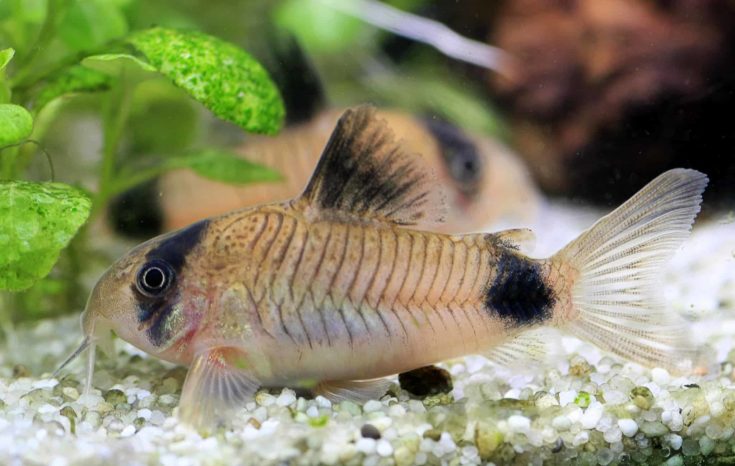
- Size: 2 to 3 inches
- Care difficulty: Easy/Beginner
- Minimum tank size: 10 gallons
- Water temperature: 65° to 80° Fahrenheit
Of all the varieties of Corydoras catfish, there are a few that can survive in a cold water tank. The Panda cory is an adorable little fish that falls into that category.
The Panda cory is a cute little fish that makes a good addition to a community tank. However, you should be wary of putting these guys in the same tank as large goldfish, as they may be viewed as lunch! That’s a big problem because the cory has several spines along its back that will get stuck in the goldfish’s throat, potentially killing both parties.
Ideally, you should keep corys in groups of five or six individuals.
27. Pygmy Sunfish
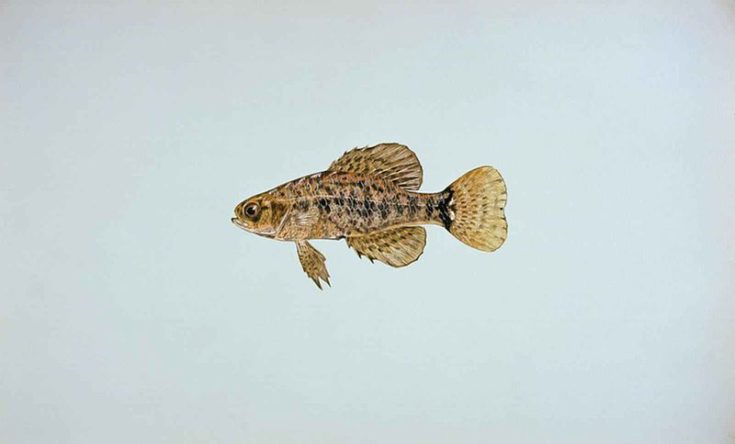
- Size: 1.5 to 2 inches
- Care difficulty: Intermediate
- Minimum tank size: 5 to 10 gallons
- Water temperature: 60° to 75° Fahrenheit
Pygmy Sunfish are absolutely beautiful, and there are several species of these delightful metallic fishes to choose from. Although suitable for coldwater tanks, you can also keep sunfish in an outdoor pond.
Unfortunately, these swimming jewels are very shy and don’t generally do well in community tanks, so a species-specific setup is preferred. Also, Pygmy Sunfish can be picky when it comes to food, which makes keeping them healthy a challenge.
28. Axolotl
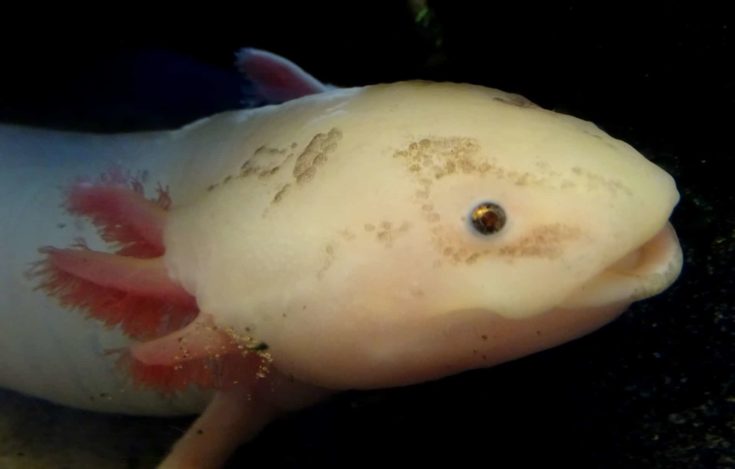
- Size: 1.5 to 2 inches
- Care difficulty: Intermediate
- Minimum tank size: 40 gallons
- Water temperature: 60° to 70° Fahrenheit
The Axolotl is a species of salamander that never makes the jump from its larval stage to adulthood. You’ll need a large tank to accommodate one of these creatures, as they can grow to reach a foot in length.
Axolotls are relatively inactive, spending most of their time languishing in the depths of the tank. These are confirmed coldwater animals that do not tolerate water temperatures over 70° Fahrenheit.
29. Least Killifish
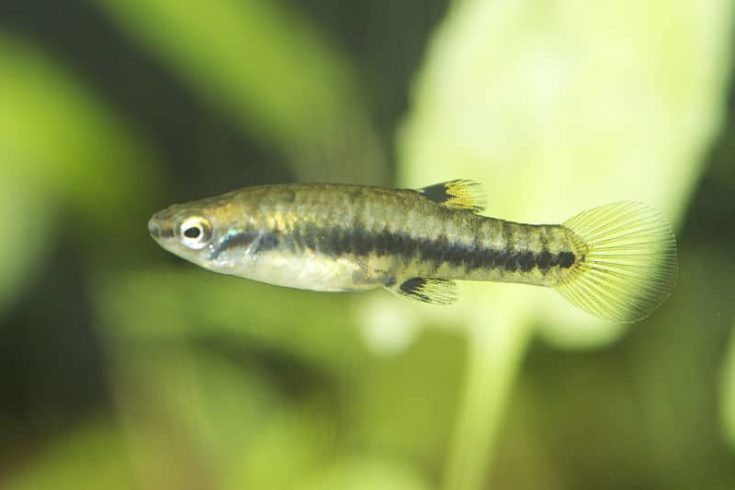
- Size: 0.75 to 1.5 inches
- Care difficulty: Easy/Beginner
- Minimum tank size: Nano
- Water temperature: 65° to 80° Fahrenheit
The Least Killifish is actually the smallest known livebearer, rather than a killifish.
These livebearers produce just one fully-formed fry every few days, rather than releasing their babies in batches of 30 or more. Least Killifish are happy in a cold water tank that’s kept in a warm room, although they can tolerate slight fluctuations in temperature. These tiny fishes are quite shy, and they prefer a heavily planted tank with lots of hiding places and they can be kept in a nano tank.
30. Celestial Pearl Danio
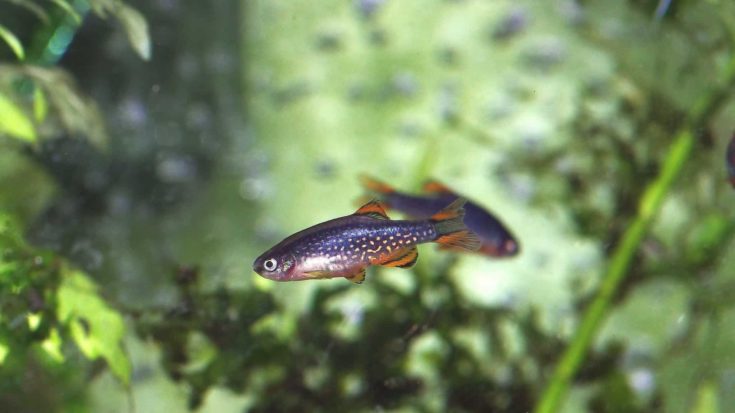
- Size: 1 inch
- Care difficulty: Easy/Beginner
- Minimum tank size: Nano
- Water temperature: 65° to 75° Fahrenheit
The Celestial Pearl Danio (Danio margaritatus) is a beautiful little nano fish that was only recently discovered in 2006. These tiny fish look just like miniature brook trout with their gold spotted bodies and red-orange colored finnage.
If you do decide to introduce a school of these timid fish, be sure to provide plenty of dense planting so that they have lots of hiding places. House your danios with shoals of other small, peaceful fish, and you will have a lively, vibrant community to enjoy, especially when the male fish begin circling each other in a kind of social dance.
31. One-Sided Livebearer
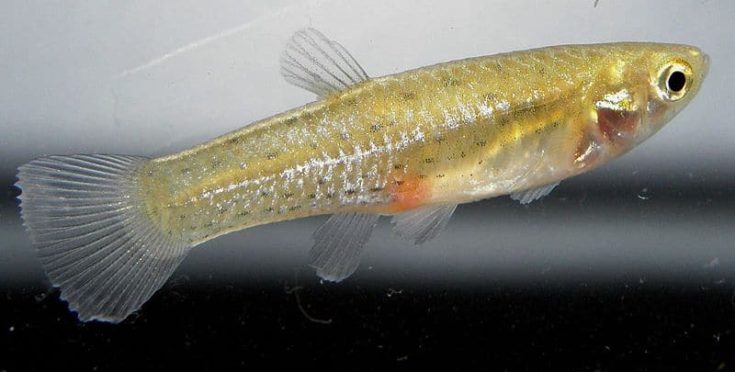
- Size: 1 inch
- Care difficulty: Easy/Beginner
- Minimum tank size: Nano
- Water temperature: 60° to 73° Fahrenheit
One-sided livebearers are seldom seen in the home tank, and they are not easy to obtain unless you shop online. Like guppies and other livebearers, the One-sided livebearer breeds prolifically, so you’ll never be short of them.
These fish are pretty hardy characters that make an attractive, shimmering display when kept in a small shoal as part of a community tank setup. One-sided livebearers are extremely active and entertaining to watch, but they can be quite shy and easily spooked, so you must provide them with plenty of dense plant cover in the aquarium where the fish can take shelter if they need to.
Benefits Of Keeping Coldwater Fish
When you are new to the fish keeping hobby, your first consideration is going to be what kind of fish you want to keep. Most newbies begin by keeping coldwater fish, and there are several advantages to that.
Cheaper
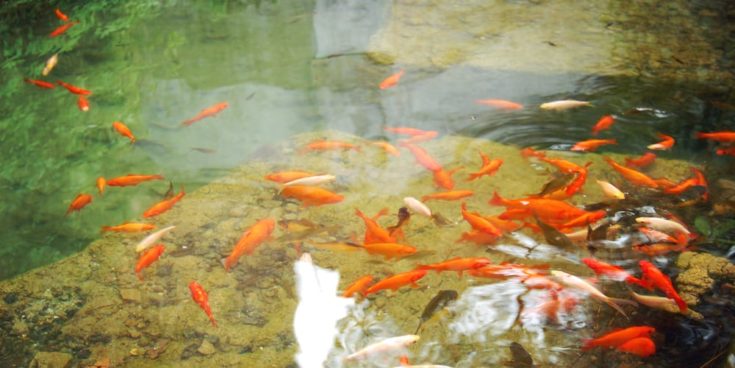
Coldwater fish tanks typically tend to be cheaper to buy and maintain than tropical ones. For one thing, you don’t need to buy a heater and a thermometer, and you won’t be paying for expensive electricity.
Also, many species of coldwater fish are not as expensive to purchase as tropical ones, although coldwater fishes can be just as colorful and beautiful to look at as their warm-water cousins.
Fish Health
In general, coldwater fish tend to enjoy a longer lifespan than tropical ones, although there are always exceptions.
Also, provided that they are kept in a clean tank and fed the correct diet, coldwater fish are not as prone to as many diseases as tropical fish. Many tropical species are highly susceptible to temperature shock if the tank water becomes too cold or even too warm. So, if your heater fails or the thermostat malfunctions, your fish could become sick and even die.
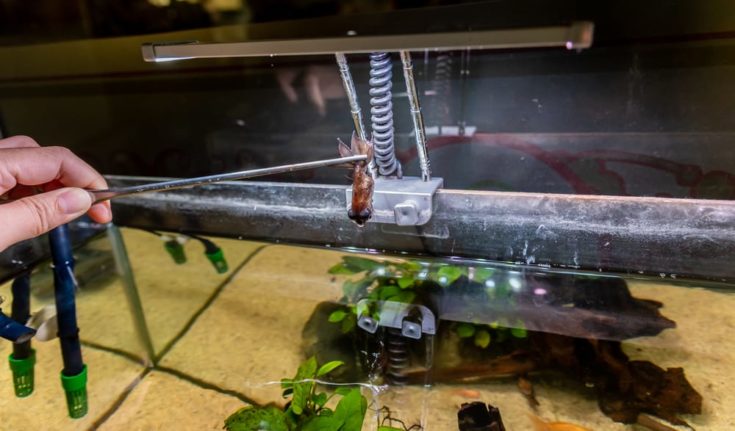
That being said, coldwater fish will overheat if the water in their aquarium becomes too warm. Overheating stresses the fish, which, in turn, leaves them vulnerable to disease or attack by parasites. So, when you position your aquarium, make sure that it’s well away from sources of ambient heat and direct sunlight.
Less Algae
Although algae can look unsightly when your tank glass, decorations, and surfaces are covered with it, the presence of this green, mossy growth doesn’t mean that your aquarium is unhealthy. Like all plants, algae needs a source of nutrition and light to flourish. In the aquarium, fish waste and decomposing food provide plenty of nutrients, and aquarium lighting does the rest.
Many species of algae grow more quickly and vigorously in warm water. So, a tropical tank is more likely to have an algae problem than a coldwater setup. However, my goldfish tank has plenty of algae growing in it! That’s most likely because my home is quite warm, and it isn’t a problem for my two fantails who spend a lot of time grazing on the algae, treating it as an all-you-can-eat buffet!
Tank Care And Maintenance
When it comes to caring for a coldwater setup, the maintenance requirements are pretty similar to those of a tropical tank.
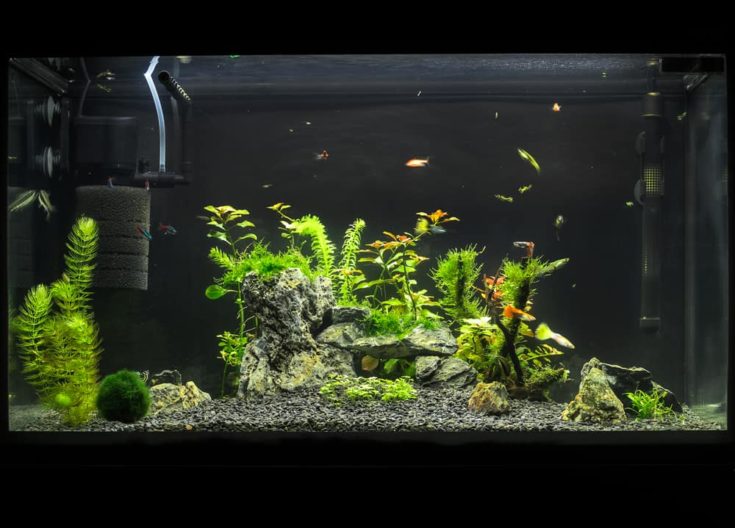
Although your tank won’t have a heater, you will need to fit a filtration system, especially if you plan on keeping goldfish, which are notoriously dirty creatures. Your tank will also have a lighting unit. That’s important for plant growth and provides illumination to show off your fish.
Once a week, you’ll need to clean your fish tank and maintain the filter. Tank maintenance entails cleaning the substrate with an aquarium vacuum, carrying out a partial water change, and rinsing the filter media in tank water. You might also need to remove algae from the glass so that you can see your fish. However, it’s best to leave biofilm in place on ornaments and decorations, as that provides a surface on which beneficial bacteria can proliferate, helping the biological filter to remove ammonia and nitrites from the water that would otherwise harm your fish.
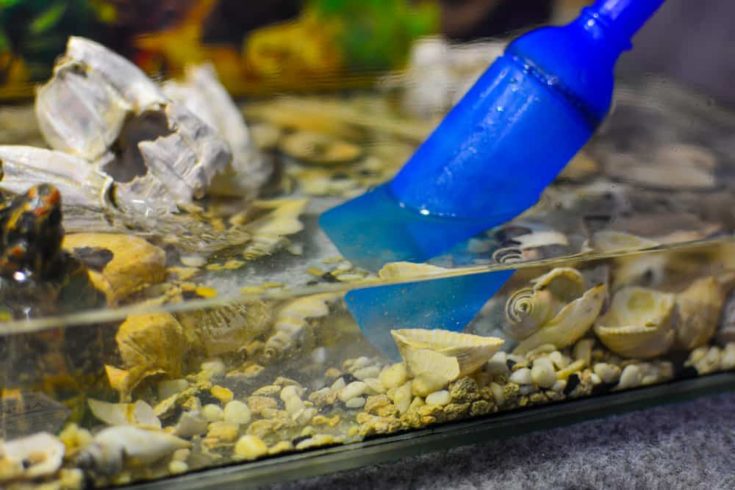
If you keep living plants in your aquarium, you will need to trim away dead leaves and keep the plants pruned so that they don’t overcrowd the tank.
In Conclusion
I hope that you enjoyed this guide to the best fish species for a cold, freshwater aquarium.
There are plenty of benefits to be gained from keeping coldwater fish, and, as you can see from our list, there are lots of species to choose from. Coldwater fish are just as colorful and entertaining as tropicals, they tend to be hardier and less prone to diseases, and you don’t need to worry about the additional expense of providing a heater, thermostat, or thermometer in your tank.
If you found this article informative and interesting, please share it with other enthusiasts. Please tell us what you think and feel free to ask any questions by using the comments box below.
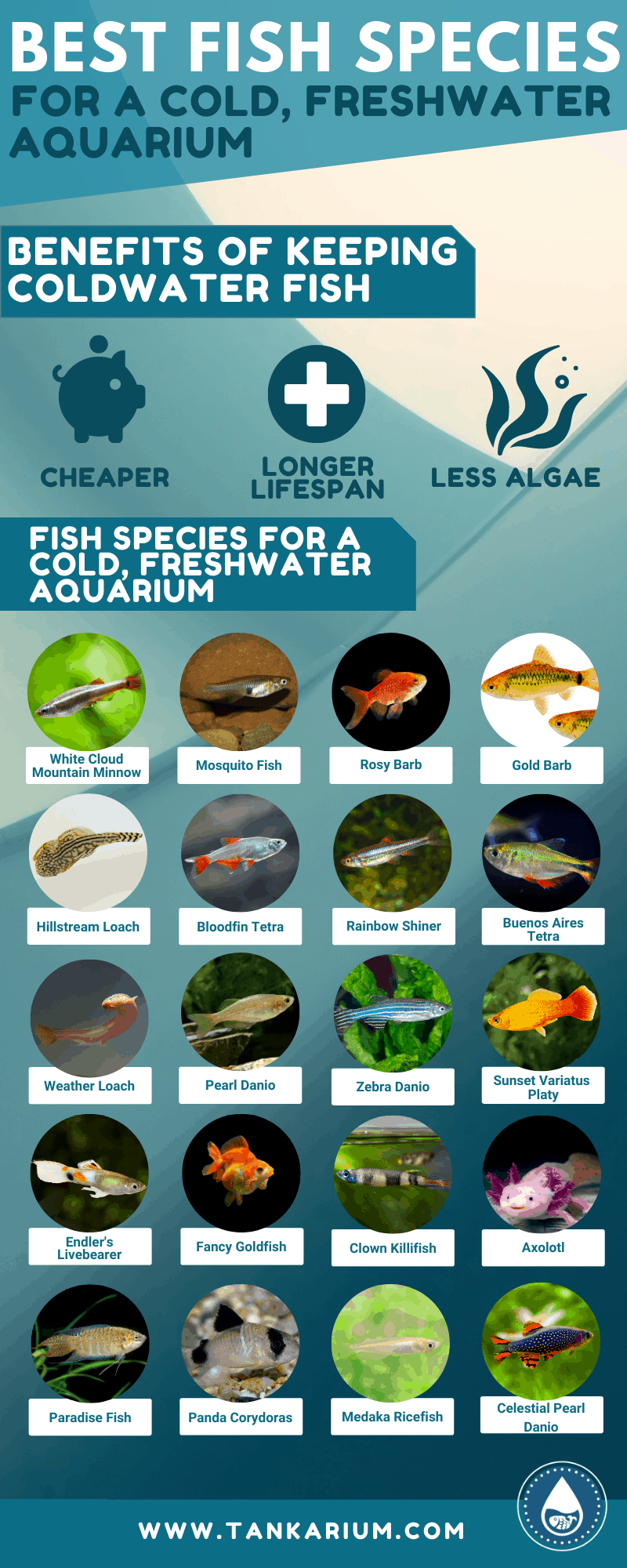
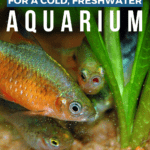
Thank you that was great